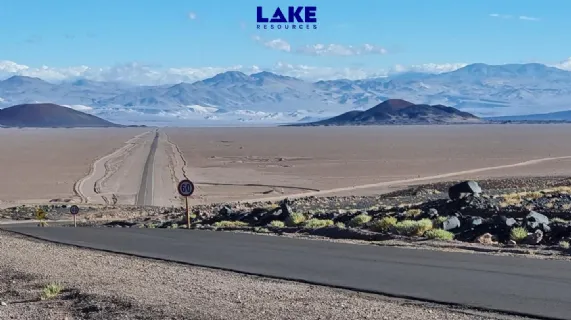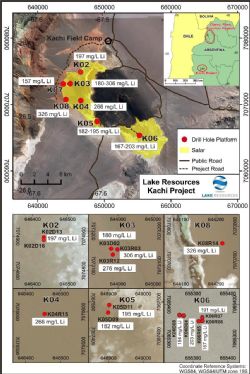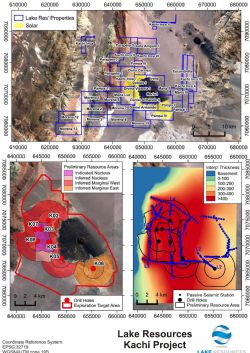
Large Maiden 4.4mt LCE Resource Estimate for Kachi Project
Brisbane, Nov 28, 2018 AEST (ABN Newswire) - Argentine-focused lithium exploration and project development company Lake Resources NL ( ASX:LKE) is pleased to release a large maiden resource estimate for Lake's 100% owned Kachi Lithium Brine Project in Argentina (see Figure 1 in link below).
ASX:LKE) is pleased to release a large maiden resource estimate for Lake's 100% owned Kachi Lithium Brine Project in Argentina (see Figure 1 in link below).
- Maiden Mineral Resource estimate of 4.4 million tonnes of contained Lithium Carbonate Equivalent in Inferred and Indicated Categories extending to 400m below ground level in porous, permeable sediments.
- Indicated Mineral Resource estimate of 1.0 million tonnes of Lithium Carbonate Equivalent (LCE) in the central area of Kachi.
- Inferred Mineral Resource estimate of 3.4 million tonnes LCE in the surrounding area.
- Estimate based on results of 15 drill holes. Brine bearing sediments remain open at depth and laterally with opportunity for resource expansion from additional deeper drilling and extending the area of exploration drilling.
- Resource estimate centred within an exploration target with potential for 8 to 17 million tonnes LCE over 20 km x 15km with brines from surface to 400+ metres depth, demonstrating scale of the project of a similar size to globally significant lithium producers.
The maiden resource estimate contains 1 Mt of lithium carbonate equivalent (LCE) as Indicated resources, and 3.4 Mt of LCE as Inferred resources, with a resource depth of 400m for both areas (see Table 2 in link below).
Lake Resources Managing Director Steve Promnitz said: "We are very pleased to report such a significant maiden JORC Mineral Resource estimate for Kachi. The team advanced drilling within 12 months on an undrilled project, and defined a large resource and located a project that stands alongside the largest lithium projects in Argentina."
"We will expand the resource with more drilling and move into a pre-feasibility study using conventional and a direct extraction technology from Lilac Solutions which indicate high recoveries, low costs and a reduced time to production of lithium."
Project Background
Lake Resources' 100%-owned Kachi Lithium Brine Project in Catamarca province, Argentina covers 69,000 hectares (170,000 acres) with 36 mining leases owned by Lake's Argentine subsidiary, Morena del Valle Minerals SA. These are held over the centre and southern extension of the salt lake at Kachi in the lowest point (around 3000 m altitude) of a large drainage area of approximately 6800 square kilometres (2500 square miles). The basin drains the lithium bearing volcanic rocks of Cerro Galan, which is interpreted to provide the lithium for the FMC Lithium (Livent) production at Hombre Muerto, together with hot springs. Surface samples with positive lithium results in brines were explored at depth through the drilling and geophysics programs.
Drilling at Kachi has returned positive lithium values in the southwest of the project, where the passive seismic geophysics suggests the basin is the deepest, and brine extends under cover to the south.
Resource Summary
The company has to date drilled 15 brine investigation drill holes to depths of up to 403m across principal target areas of the Kachi salt lake (see Figure 1 in link below). This has revealed thick permeable sand dominated sediments that are expected to continue below current drilling depth limits and beyond the surface dimensions of the salt lake. The ongoing 2017-2018 investigation program has completed a total of 3150m of drilling to date, comprising diamond drill holes, rotary wells and installation of test production bores. The table in link below and Table 2 (see link below) outline the resource reported in accordance with the JORC Code (2012) and estimated by a Competent Person as defined by the JORC Code.
To view tables and figures, please visit:
http://abnnewswire.net/lnk/6B74IT10
About Lake Resources NL
 Lake Resources NL (ASX:LKE) (OTCMKTS:LLKKF) is a clean lithium developer utilising state-of-the-art ion exchange extraction technology for production of sustainable, high purity lithium from its flagship Kachi Project in Catamarca Province within the Lithium Triangle in Argentina among three other projects covering 220,000 ha.
Lake Resources NL (ASX:LKE) (OTCMKTS:LLKKF) is a clean lithium developer utilising state-of-the-art ion exchange extraction technology for production of sustainable, high purity lithium from its flagship Kachi Project in Catamarca Province within the Lithium Triangle in Argentina among three other projects covering 220,000 ha.
This ion exchange extraction technology delivers a solution for two rising demands - high purity battery materials to avoid performance issues, and more sustainable, responsibly sourced materials with low carbon footprint and significant ESG benefits.
| ||
|












